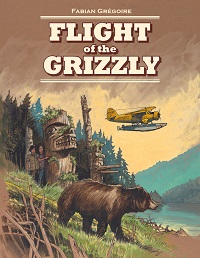| ________________
CM . . . . Volume XXIV Number 22. . . . February 9, 2018
excerpt:
Flight of the Grizzly is translation of the French book Le vol du grizzly. While this book might be entertaining reading for French youth, it will not impress many young Canadian readers. The plot is implausible, and some of the indigenous content is appropriated. The story is also based on common stereotypes of Canada being overrun with bears. The book is beautifully illustrated, and the work accurately represents what the coast of British Columbia looks like. The indigenous art is lovely to look at but is not authentic. The text is also problematic. Different indigenous stories are woven into the larger tale, and they are often presented just as ‘indigenous’. One character, George, is Kwakwaka’wakw, but he mostly identifies animals on totem poles for Jess and shares the story behind one mask which was inexplicably lying around the forest floor. There is not a lot of context offered to provide a better understanding of the culture(s). After viewing totem poles, Jess and George get on a small float plane with a sedated grizzly bear that is not in a bear proof cage but is, instead, wrapped up in a net. The bear is not properly sedated and starts to wake up, understandably annoyed that it is trapped in a small plane. A series of predictable events lead to Jess’ crashing the plane and the bear escaping. There is an attempt to bring the indigenous legends back into the story, but it does not really work. The last few pages contain non fiction information on British Columbia and Indigenous Canadians. Again, this content is surface level and would be more interesting to European readers than Canadians. As schools and libraries work to include more indigenous content and participate in the Reconciliation process, it is hard to recommend a book like this one. I believe there are better Canadian and indigenous stories out there for our collections. Not Recommended. Sophia Hunter is a teacher librarian at Crofton House Junior School in Vancouver, BC.
Next Review |
Table of Contents for This Issue
- February 9, 2018. |
